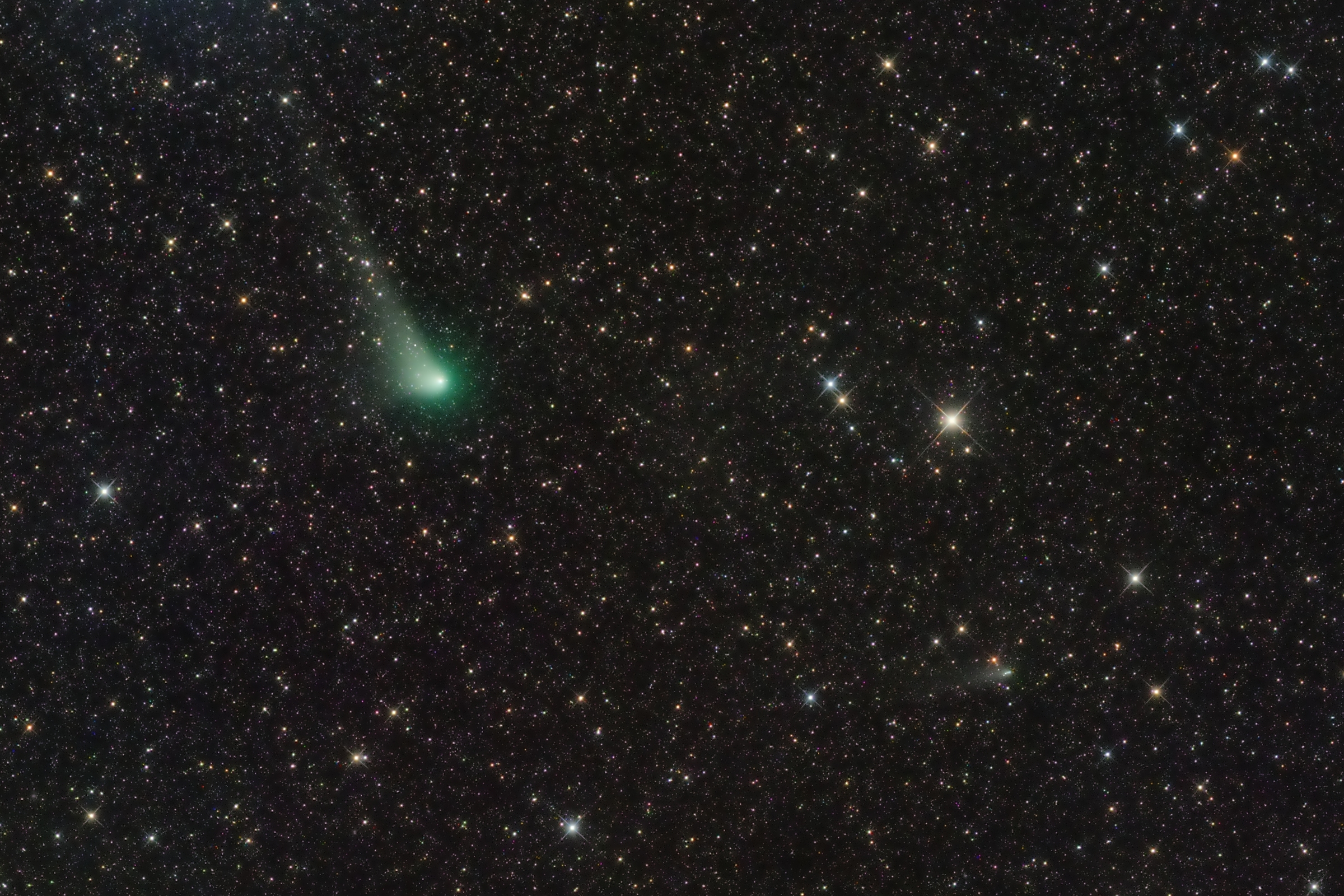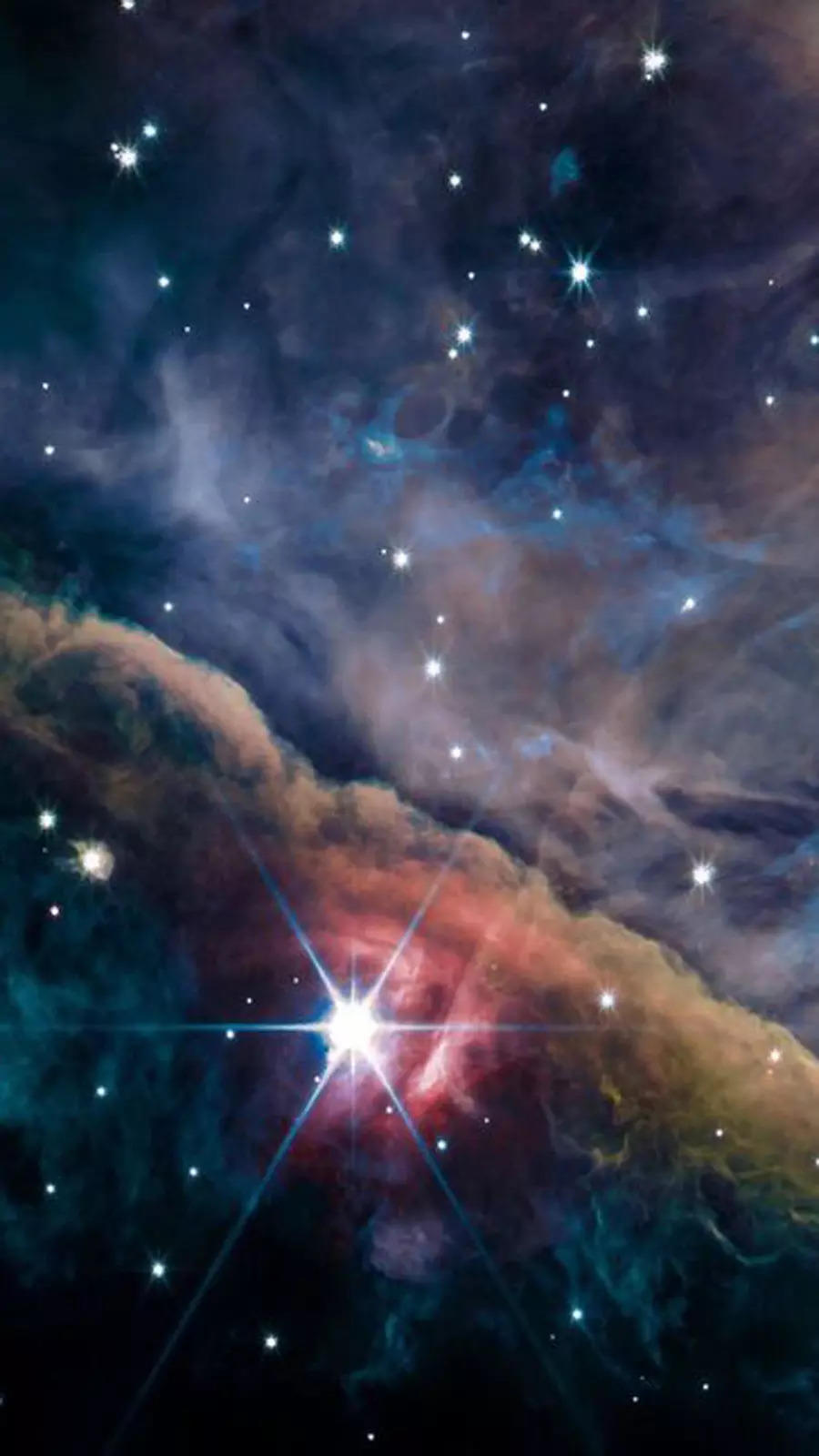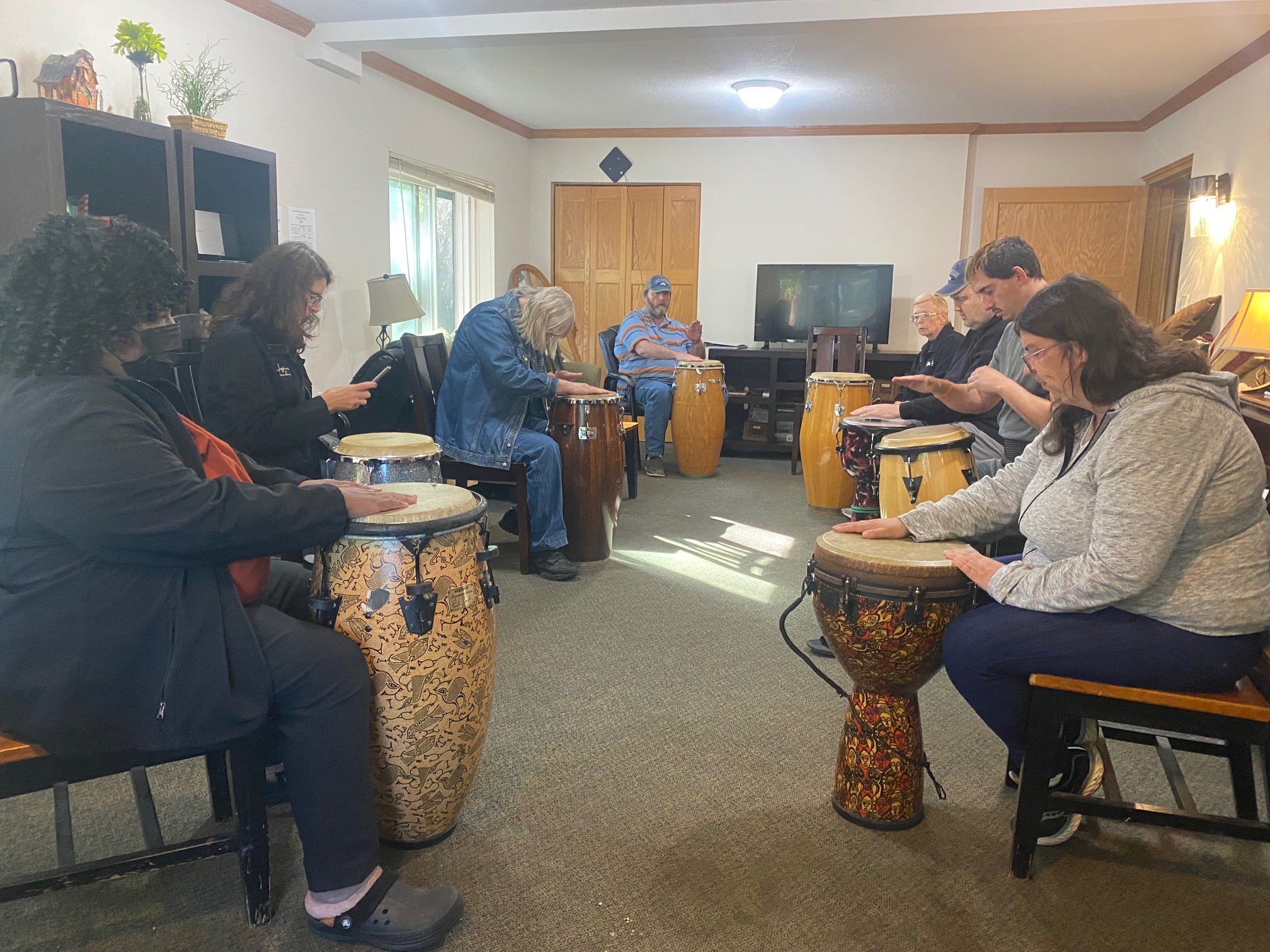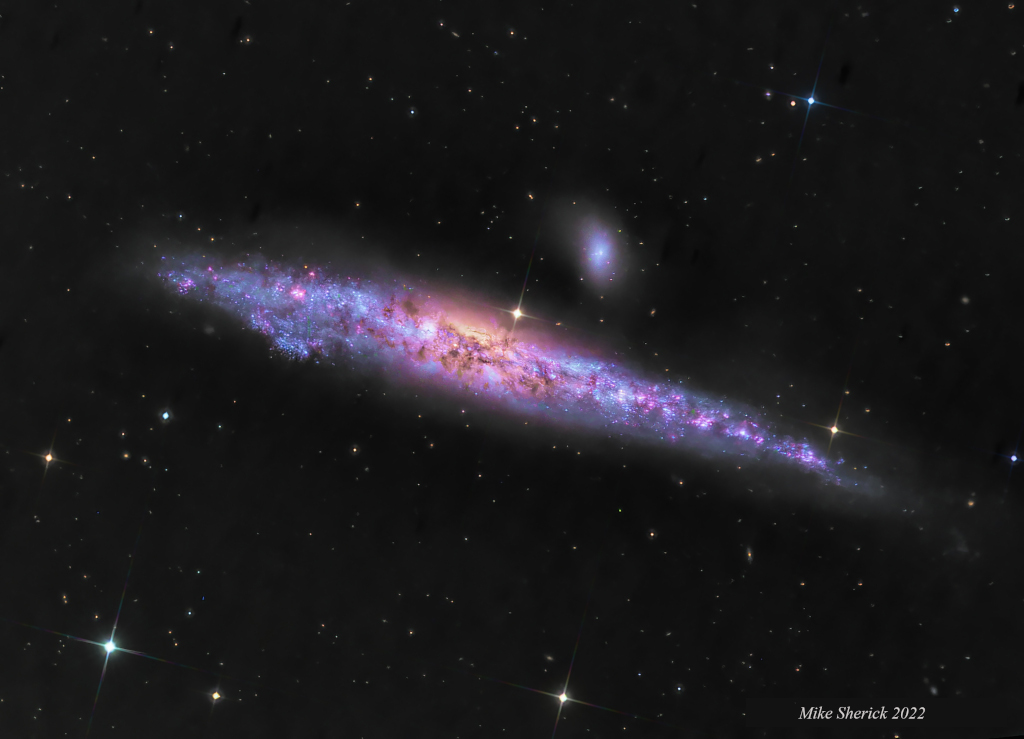Blog
Heading for its closest approach to the Sun or perihelion on December 20, comet C/2017 K2 (PanSTARRS) remains a sight for telescopic observers as it sweeps through planet Earth’s southern hemisphere skies. First time visitor from the remote Oort cloud this comet PanSTARRS sports a greenish coma and whitish dust tail about half a degree long at the upper left in a deep image from September 21. It also shares the starry field of view toward the constellation Scorpius with another comet, 73P/Schwassmann-Wachmann 3, seen about 1 degree below and right of PanSTARRS. Astronomers estimate that first time visitor comet C/2017 K2 (PanSTARRS) has been inbound from the Oort cloud for some 3 million years along a hyperbolic orbit. Schwassmann-Wachmann 3 is more familiar though. The periodic comet loops through its own elliptical orbit, from just beyond the orbit of Jupiter to the vicinity of Earth’s orbit, once every 5.4 years. Just passing in the night, this comet PanSTARRS is about 20 light-minutes from Earth in the September 21 image. Seen to be disintegrating since 1995, Schwassmann-Wachmann 3 was about 7.8 light-minutes away.

Al Duncan (October 8, 1927, McKinney, Texas — January 3, 1995, Las Vegas) was an American drummer and songwriter. Music critic and musicologist Eugene Chadbourne described Duncan as a “forefather of rhythm and blues” and “one of less than a half dozen key studio legends of the 1950s and 1960s who have sometimes been called the ‘grandfathers of groove’.” Chadbourne credited Duncan as helping develop the characteristic metric feel or timekeeping of rhythm and blues. His work is featured on recordings with Roy Buchanan, Billy “The Kid” Emerson, Buddy Guy, Dale Hawkins, Red Holloway, Camille Howard, Horace Palm, Jimmy Reed, Phil Upchurch, and Rob Wasserman among others.[2] Of the songs he penned, the best known is “It’s Too Late, Brother” which has become a blues staple.
more...Park Frederick “Pepper” Adams III (October 8, 1930 – September 10, 1986) was an American jazz baritone saxophonist and composer. He composed 42 pieces, was the leader on eighteen albums spanning 28 years, and participated in 600 sessions as a sideman. He worked with an array of musicians, and had especially fruitful collaborations with trumpeter Donald Byrd and as a member of the Thad Jones/Mel Lewis Big Band.
Pepper Adams was born in Highland Park, Michigan, to father Park Adams II, who worked as the manager of a furniture store, and mother Cleo Marie Coyle.Both of his parents were college graduates, with each spending some time at the University of Michigan. Due to the onset of the Great Depression, Adams’ parents separated to allow his father to find work without geographic dependence. In the fall of 1931, Adams moved with his mother to his extended family’s farm near Columbia City, Indiana, where food and support were more readily available. In 1933, Adams began playing piano. His father having reunited with the family, they moved to Rochester, New York, in 1935 and in that city he began his musical efforts on tenor sax and clarinet.
more...The Orion Nebula (also known as Messier 42, M42, or NGC 1976) is a diffuse nebula situated in the Milky Way, being south of Orion’s Belt in the constellation of Orion. It is one of the brightest nebulaeand is visible to the naked eye in the night sky with apparent magnitude 4.0. It is 1,344 ± 20 light-years(412.1 ± 6.1 pc) away and is the closest region of massive star formation to Earth. The M42 nebula is estimated to be 24 light-years across (so its apparent size from Earth is approximately 1 degree). It has a mass of about 2,000 times that of the Sun. Older texts frequently refer to the Orion Nebula as the Great Nebula in Orion or the Great Orion Nebula. This image from JWST.

more...
John J. Mellencamp (born October 7, 1951 Seymour, IN), previously known as Johnny Cougar, John Cougar, and John Cougar Mellencamp, is an American singer-songwriter. He is known for his catchy brand of heartland rock, which emphasizes traditional instrumentation.
Mellencamp rose to fame in the 1980s while “honing an almost startlingly plainspoken writing style” that, starting in 1982, yielded a string of Top 10 singles, including “Hurts So Good“, “Jack & Diane“, “Crumblin’ Down“, “Pink Houses“, “Lonely Ol’ Night“, “Small Town“, “R.O.C.K. in the U.S.A.“, “Paper in Fire“, and “Cherry Bomb“. He has amassed 22 Top 40 hits in the United States. In addition, he holds the record for the most tracks by a solo artist to hit number one on the Hot Mainstream Rock Tracks chart, with seven. Mellencamp has been nominated for 13 Grammy Awards, winning one. His latest album of original songs, Strictly a One-Eyed Jack, was released on January 21, 2022. Mellencamp has sold over 30 million albums in the US and over 60 million worldwide.
Mellencamp is also one of the founding members of Farm Aid, an organization that began in 1985 with a concert in Champaign, Illinois, to raise awareness about the loss of family farms and to raise funds to keep farm families on their land. Farm Aid concerts have remained an annual event over the past 37 years, and as of 2022 the organization has raised over $60 million.
Mellencamp was inducted into the Rock and Roll Hall of Fame in 2008, followed by an induction into the Songwriters Hall of Fame in 2018.
more...Yo-Yo Ma (Chinese: 馬友友 Ma Yo Yo; born October 7, 1955) is an American cellist. Born in Paris to Chinese parents and educated in New York City, he was a child prodigy, performing from the age of four and a half. He graduated from the Juilliard School and Harvard University and attended Columbia University and has performed as a soloist with orchestras around the world. He has recorded more than 90 albums and received 19 Grammy Awards.
In addition to recordings of the standard classical repertoire, Ma has recorded a wide variety of folk music, such as American bluegrass music, traditional Chinese melodies, the tangos of Argentine composer Astor Piazzolla, and Brazilian music. He has collaborated with artists in diverse genres, including the singer Bobby McFerrin, the guitarist Carlos Santana, Sérgio Assad and his brother, Odair, and the singer-songwriter-guitarist James Taylor. Ma’s primary performance instrument is a 1733 Montagnana cello valued at US$2.5 million.
Ma has been a United Nations Messenger of Peace since 2006. He was awarded The Glenn Gould Prize in 1999, the National Medal of Arts in 2001, the Presidential Medal of Freedom in 2011, and the Polar Music Prize in 2012. Ma was named one of Time‘s 100 Most Influential People of 2020.
Ma’s mother, Marina Lu, was a singer, and his father, Hiao-Tsiun Ma, was a violinist, composer and professor of music at Nanjing National Central University (now relocated in Taoyuan, Taiwan; predecessor of the present-day Nanjing University and Southeast University). They both migrated from the Republic of China to France during the Chinese Civil War.
more...Larry Young (also known as Khalid Yasin [Abdul Aziz]; October 7, 1940 – March 30, 1978) was an American jazz organist and occasional pianist. Young’s early work was strongly influenced by the soul jazz of Jimmy Smith, but he later pioneered a more experimental, modal approach to the Hammond B-3.
Born and raised in Newark, New Jersey, United States, Young attended Newark Arts High School, where he began performing with a vocal group and a jazz band.
Young played with various R&B bands in the 1950s, before gaining jazz experience with Jimmy Forrest, Lou Donaldson, Kenny Dorham, Hank Mobleyand Tommy Turrentine. Recording as a leader for Prestige from 1960, Young made a number of soul jazz discs, Testifying, Young Blues and Groove Street. When Young signed with Blue Note around 1964, his music began to show the marked influence of John Coltrane. In this period, he produced his most enduring work. He recorded several times as part of a trio with guitarist Grant Green and drummer Elvin Jones, who were occasionally augmented by additional players. Most of these albums were released under Green’s name, though Into Somethin’ (with Sam Rivers on saxophone) became Young’s Blue Note debut. In March 1978, he checked into the hospital for stomach pains. He died there on March 30, 1978, while being treated for what is said to be pneumonia. However, the actual cause of his death is unclear.
more...Jonathan David Samuel Jones (October 7, 1911 – September 3, 1985) was an American jazz drummer. A band leader and pioneer in jazz percussion, Jones anchored the Count Basie Orchestra rhythm section from 1934 to 1948. He was sometimes known as Papa Jo Jones to distinguish him from younger drummer Philly Joe Jones. Born in Chicago, Illinois, United States, Jones moved to Alabama, where he learned to play several instruments, including saxophone, piano, and drums. He worked as a drummer and tap-dancer at carnival shows until joining Walter Page‘s band, the Blue Devils in Oklahoma City in the late 1920s. He recorded with trumpeter Lloyd Hunter‘s Serenaders in 1931, and later joined pianist Count Basie‘s band in 1934. Jones, Basie, guitarist Freddie Green and bassist Walter Page were sometimes billed as an “All-American Rhythm section,” an ideal team. Jones took a brief break for two years when he was in the military, but he remained with Basie until 1948. He participated in the Jazz at the Philharmonic concert series.
He was one of the first drummers to promote the use of brushes on drums, and shifting the role of timekeeping from the bass drum to the hi-hatcymbal. Jones had a major influence on later drummers such as Buddy Rich, Kenny Clarke, Roy Haynes, Max Roach, and Louie Bellson. He also starred in several films, most notably the musical short Jammin’ the Blues (1944).
more...Derived from flamenco’s earliest root forms, the tonás, siguiriyas is one of flamenco’s oldest and deepest forms. Its name is a corruption of the term seguidillas, a group of 18th Century songs and dances. Siguiriyas first emerged in the 18th Century in Cádiz, Sevilla and Jerez de la Frontera. Slow, majestic and tragic, Siguiriyas is the most jondo of cante jondo forms. Its lyrics focus on tragedy, inconsolable sorrow, and pain. When performed without a dancer, siguiriyas opens with a solo introduction on the guitar, followed by a temple in which the singer warms up, matching tone and tempo with the guitar. The singer then sings one or more letras. The guitarist accompanies the letras with a fairly regular chord and bass note pattern, maintaining a steady pulse. As with other forms, the guitarist can insert a falseta between the letras or between the lines of a letra. If a dancer is present, they interpret the letras and falsetas, and insert escobillas and other percussive sections accompanied by a quicker, more rhythmic pattern on the guitar. The underlying compás for siguiriyas is a 12 count pattern with beats grouped as 2, 2, 3, 3, 2, and with an accent on the first beat of each group.
more...https://www.youtube.com/watch?v=MHs4SJai8Ag
more...Teaching a Rhythm Roots Workshop at Tasks Unlimited (https://tasksunlimited.org) St Louis Park location working with the Mental Health community. Celebrating world drumming and world cultures. Sept 1st thru Oct 13th on Thursdays 930-11am. Today 6th in the series.

more...
NGC 4631 is a big beautiful spiral galaxy. Seen edge-on, it lies only 25 million light-years away in the well-trained northern constellation Canes Venatici. The galaxy’s slightly distorted wedge shape suggests to some a cosmic herring and to others its popular moniker, The Whale Galaxy. Either way, it is similar in size to our own Milky Way. In this sharp color image, the galaxy’s yellowish core, dark dust clouds, bright blue star clusters, and red star forming regions are easy to spot. A companion galaxy, the small elliptical NGC 4627 is just above the Whale Galaxy. Faint star streams seen in deep images are the remnants of small companion galaxies disrupted by repeated encounters with the Whale in the distant past. The Whale Galaxy is also known to have spouted a halo of hot gas glowing in X-rays.

Little Sonny (born Aaron Willis; October 6, 1932, in Greensboro, Alabama) is an American electric blues harmonica player, singer and songwriter.[1] His early mentor and inspiration was Sonny Boy Williamson II. Nevertheless, Little Sonny stated that his nickname was originated by his mother: “[She] called me ‘Sonny boy’ from the time I can remember.” He has released eight albums, including three for a subsidiary of Stax Records. His 1973 release, Hard Goin’ Up, reached the Top 50 in the Billboard R&B chart.
Willis was born in 1932 and raised solely by his mother. He relocated to Detroit in 1953. He had no real interest in music, he said, “But then I saw Sonny Boy Williamson II.” Willis was “spellbound at the way he played. After the show I went home and practiced for hours. Every day after that I would practice until I got the sound I wanted.” His daytime job was working in a used car lot.
more...Tony Oladipo Allen (20 July 1940 – 30 April 2020) was a Nigerian drummer, composer, and songwriter who lived and worked in Paris, France. Allen was the drummer and musical director of Fela Kuti‘s band Africa ’70 from 1968 to 1979, and was one of the founders of the Afrobeat genre. Fela once stated that “without Tony Allen, there would be no Afrobeat”. He was described by Brian Eno as “perhaps the greatest drummer who has ever lived”.
Later in life, Allen collaborated with Damon Albarn on several projects, including Gorillaz, the Good, the Bad & the Queen and Rocket Juice & the Moon. Allen’s career and life were documented in his 2013 autobiography Tony Allen: Master Drummer of Afrobeat, co-written with Michael E. Veal, who previously wrote a comprehensive biography of Fela Kuti.
Allen was born in Lagos, Nigeria to James Alabi Allen, a motor mechanic from British Nigeria (now present day Nigeria) and Prudentia Mettle, from the Gold Coast(now present day Ghana), He began playing drums at the age of 18, while working as an engineer for a radio station. Allen was influenced by music his father listened to: Jùjú, a popular Yoruba music from the 1940s, but also American jazz, and the growing highlife scene in Nigeria and Ghana. Allen worked hard to develop a unique voice on the drums, feverishly studying LPs and magazine articles by Max Roach and Art Blakey, but also revolutionary Ghanaian drummer Guy Warren(later known as Kofi Ghanaba – who developed a highly sought-after sound that mixed tribal Ghanaian drumming with bop – working with Dizzy Gillespie, Charlie Parker, Thelonious Monk, and Max Roach).
more...Samuel Blythe Price (October 6, 1908 – April 14, 1992) was an American jazz, boogie-woogie and jump blues pianist and bandleader. Price’s playing is dark, mellow, and relaxed rather than percussive, and he was a specialist at creating the appropriate mood and swing for blues and rhythm and blues recordings.
Price was born in Honey Grove, Texas, United States. Price formally studied the piano with Booker T. Washington‘s daughter, Portia Marshall Washington (1883–1978). In the mid-1920s, when he was employed in a Dallas music store, Price wrote to Paramount Records recommending Blind Lemon Jefferson to the label.
During his early career, he was a singer and dancer in local venues in the Dallas area. Price lived and played jazz in Kansas City, Chicago and Detroit. In 1938 he was hired by Decca Records as a session sideman on piano, assisting singers such as Trixie Smith and Sister Rosetta Tharpe. Price’s trio accompanied Rosetta Tharpe and Marie Knight on many of their gospel recordings such as “Up Above My Head” and “Two Little Fishes and Five Loaves of Bread.”
more...Vocalist Loretta Lynn, whose ascent from a small Kentucky coal-mining community to national country music stardom literally became the stuff of Hollywood, died on Tuesday (Oct. 4) at 90. According to a statement from her family, Lynn passed away in her sleep at her home in Hurricane Mills, Tennessee. “Our precious mom, Loretta Lynn, passed away peacefully this morning, October 4th, in her sleep at home at her beloved ranch in Hurricane Mills, the family said in a statement; an announcement about a public memorial is forthcoming.
Beyond the dramatic particulars of her life, Lynn, who recorded 16 No. 1 country singles, was among the music’s groundbreaking female singing stars.
She became one of the music’s brightest luminaries in an era when men dominated country. She wrote much of her hit material, and it was sharply-penned stuff, written from the point of view of a woman (usually a married one) who would take no guff from her man. And she did not shrink from controversial subject matter.
Lynn was born Loretta Webb on April 14, 1932 in Butcher Hollow, Kentucky. “I’m always making Butcher Hollow sound like the most backward part of the United States — and I think maybe it is,” she wrote in her autobiography.
She was the second eldest of coal miner Melvin Webb’s eight children, and grew up in sometimes dire poverty in the heart of the Great Depression. One of the few distractions she had was the radio; 11-year-old Loretta became enamored of the Grand Ole Opry and its early female star, Molly O’Day.
At the age of 14, she married Oliver Lynn, known by his nicknames “Doolittle” and “Mooney.” A year later, the couple moved from Kentucky to Custer, Washington, a town of a few hundred near Bellingham. By 18, Lynn had four children. (Two more would follow later.)
Encouraged by her husband, Lynn began singing in the Washington clubs. In 1950, Don Grashey of tiny Zero Records arranged a session for her in Los Angeles. Backed by top-flight guitarists Speedy West and Roy Lanham, she cut her composition “I’m a Honky Tonk Girl,” inspired in part by Kitty Wells’ 1952 hit “It Wasn’t God Who Made Honky Tonky Angels.”
more...More Posts
- The Cosmos with ESO 580-49
- Jean Toussaint Day
- Carl Grubbs Day
- Moses Rascoe Day
- World Music with Amjad Ali Khan
- Daily Roots with Ras Shiloh
- Music for Surviving the Pandemic and Realizing Racial Justice
- The Cosmos with HUDF
- Mick Jagger Day
- Joanne Brackeen Day
- Charlie Persip Day
- Erskine Hawkins Day
- World Music with Altai-Kai
- Daily Roots with Candyman
- Music for Surviving the Pandemic and Realizing Racial Justice
- The Cosmos with SDSS J0928+2031
- Steve Goodman Day
- Don Ellis Day
- Gibson Kente Day
- Semmangudi Srinivasa Iyer Day